|
|
Post by tod2 on Oct 31, 2012 14:52:27 GMT
September is officially the start of Spring here down South. This year it was a bit late in coming to the far northern end of the Kruger Park. We arrived in fairly arid conditions, much to our surprise. The Mopani trees were just dry sticks. Having spent the first night at a B&B in Phalaborwa, we entered the park on Sunday morning - 14th Oct. Here are the photos for that day. 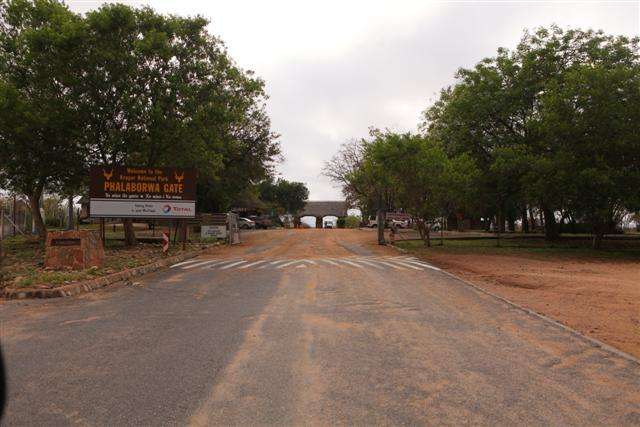 The main tarred road from this entrance gate is the H9. After 8km one encounters a dirt loop road called the S51. This leads to the Sable Dam and overlooking it, the overnight Sable Hide. Apart from one other couple looking around, we were the only ones there. 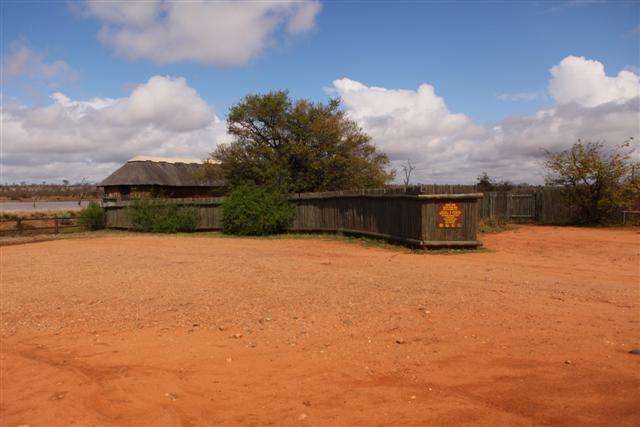 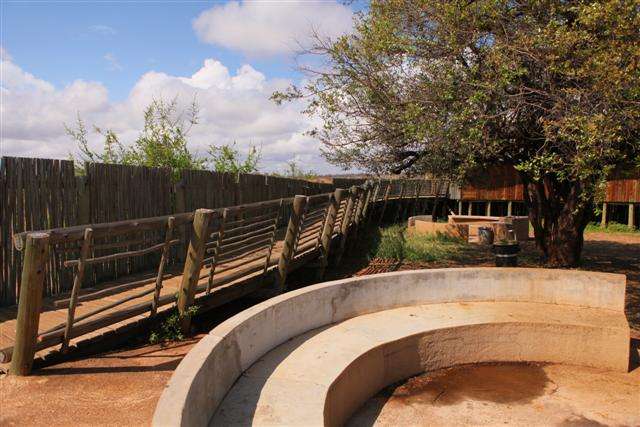 That's the loo in the little thatched hut at the far end of the boma. 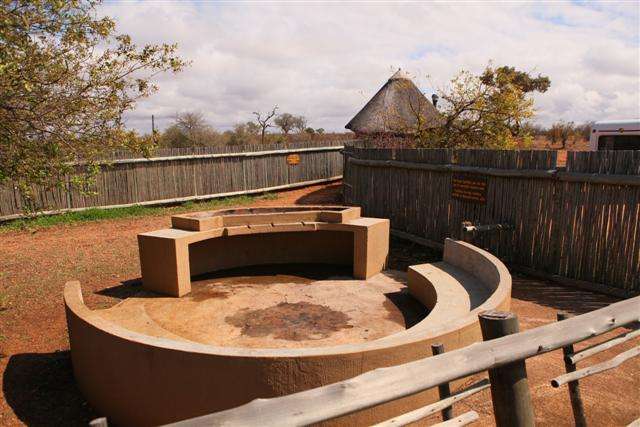 Inside the beds are stored upright in a dormitory formation. This 'sleep-over' must be very exciting for a group of senior school kids. I can just imagine the high-jinks they would get up to! I don't know how comfortable it would be sleeping amongst a group of them.....or other strangers. There is no privacy what so ever except if you head to the rustic shower and loo. 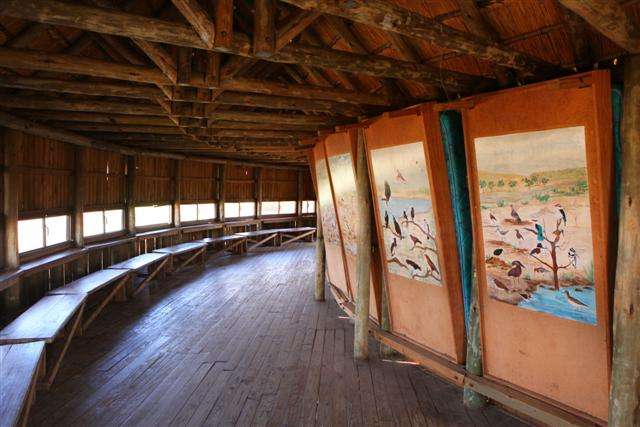 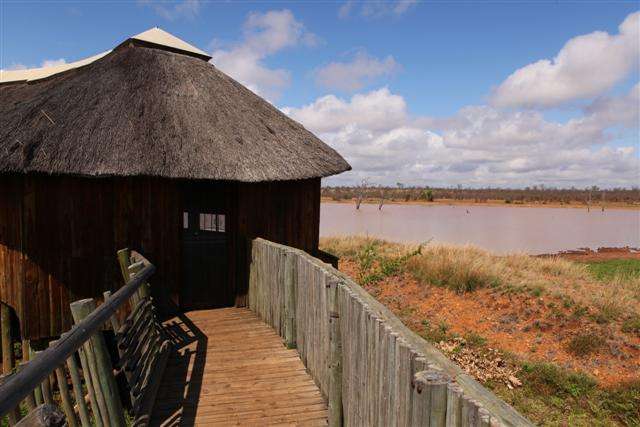 The Hide overlooking Sable Dam. 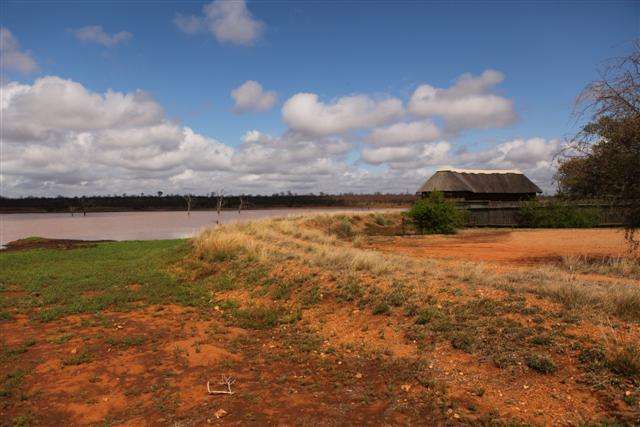 Look who we heard calling, and followed the sound - here is the wonderful Fish Eagle. 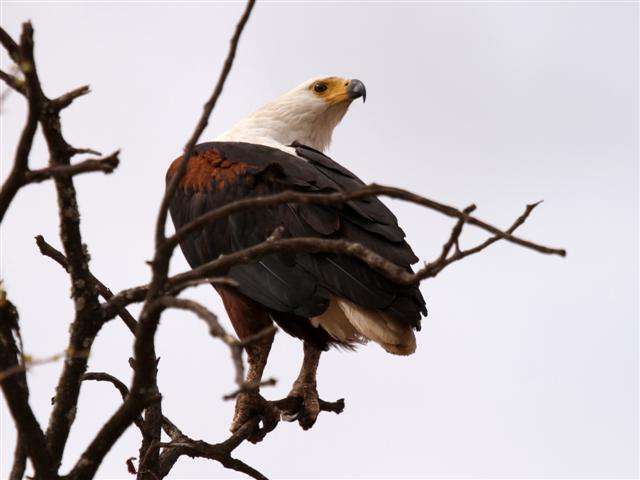 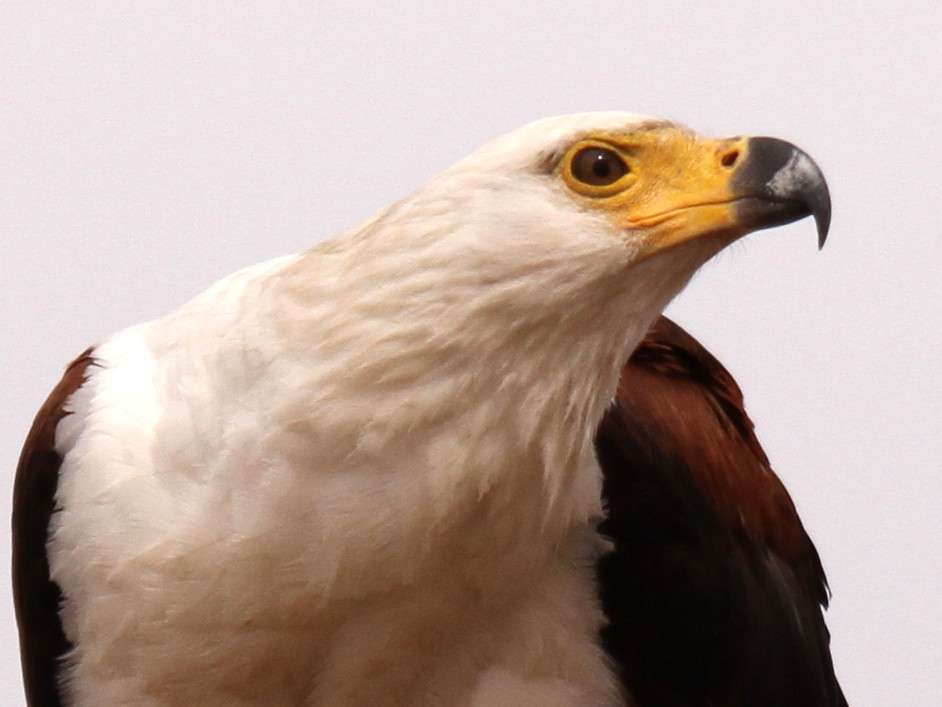 Mopani growing out of anthill. 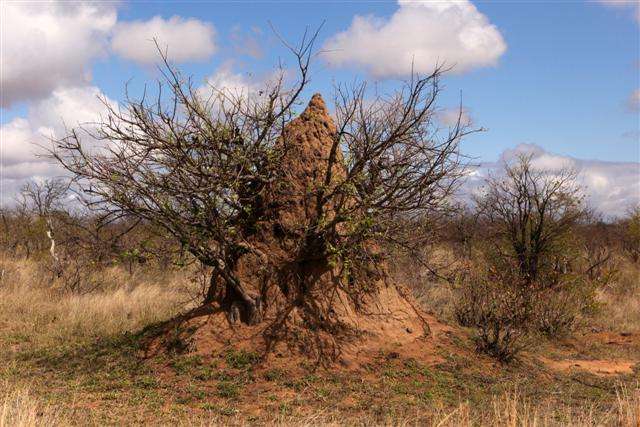 We leave the hide and take the H14 northwards and eventually converge with the H1-6 to Mopani Camp where we stop for some lunch. From the restaurant windows we watch the thatchers re-doing the roof of the building. You will notice they do have safety equipment but are far too brazen and self-assured to attach it to anything that will prevent them falling down a very steep incline. The bloke below is throwing up a bundle of grass and it is caught by the man on the pole - we only saw him miss once! 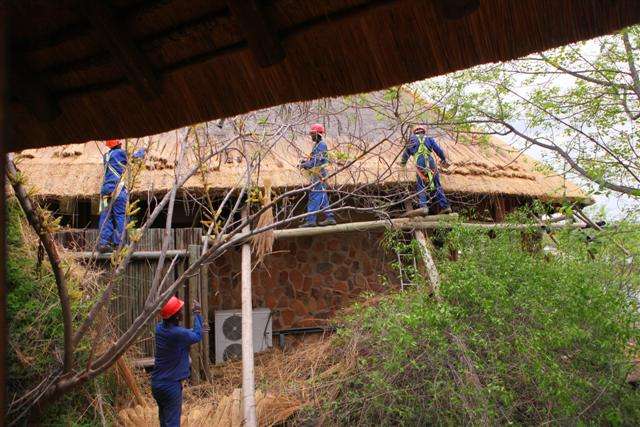  Its not too long before our second bird sighting appears - this time a beautiful Tawny Eagle. 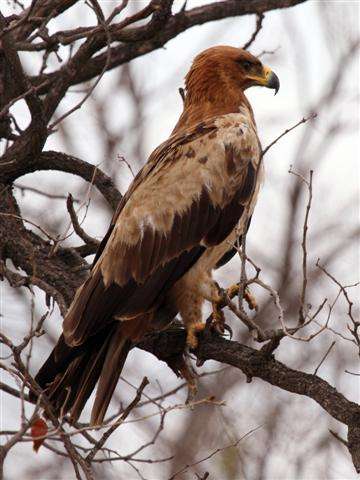 We get a close-up of this lone elephant feeding on Mopani twigs. 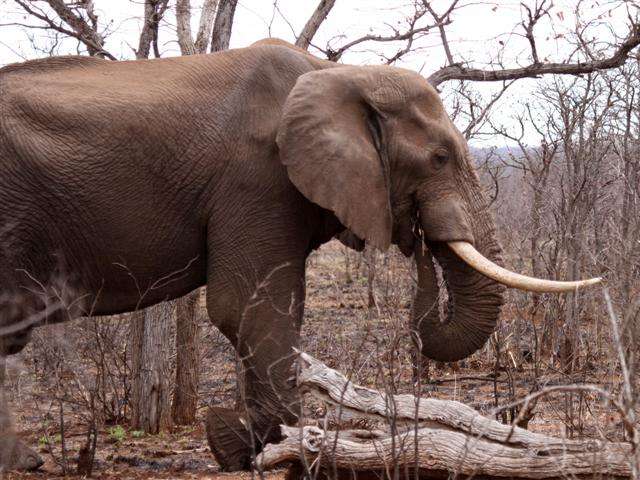 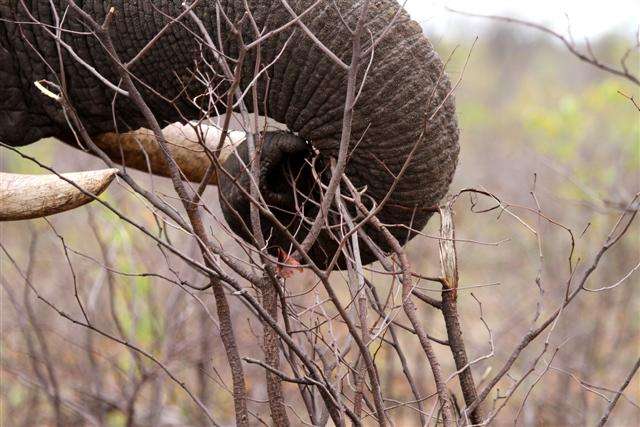 Elephants trunks are really a peculiar appendage! 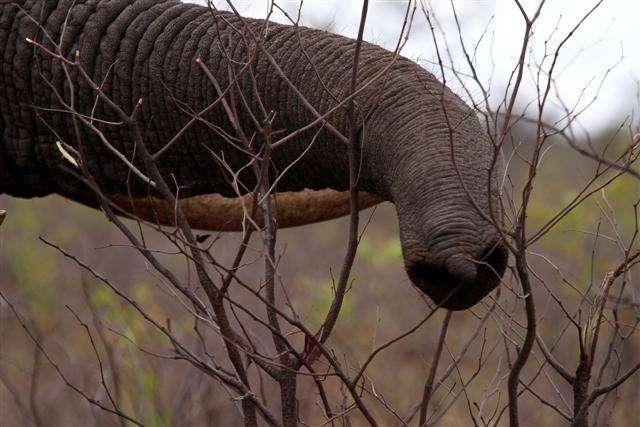 It's not long before we find the rest of the herd feeding in a dry river bed - they all take a nice long sniff at us before moving off.  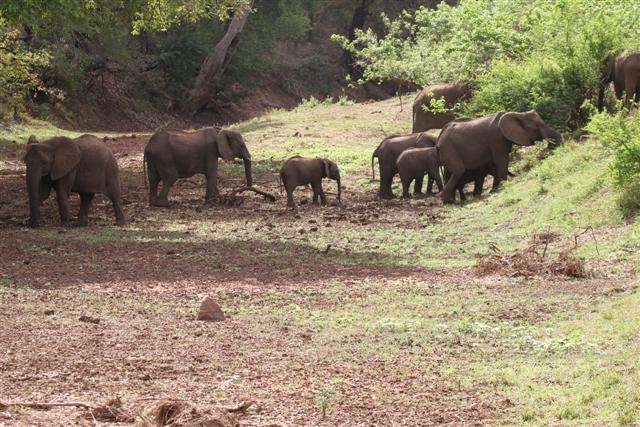 We pass Shingdwezi Camp and join the H1-7 before turning onto a dirt road - S56, to our first camp for the next four nights. Here is the private bush camp called Sirheni. 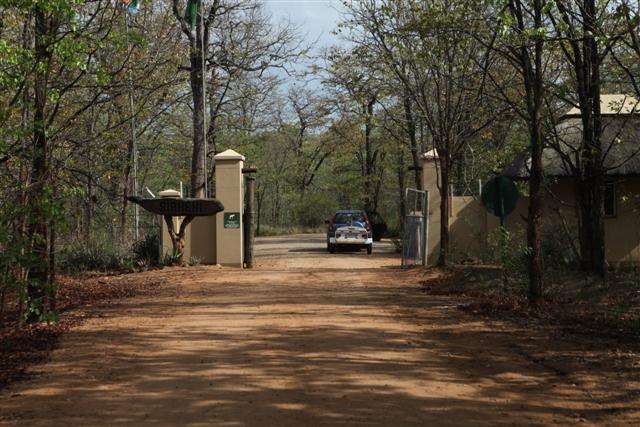 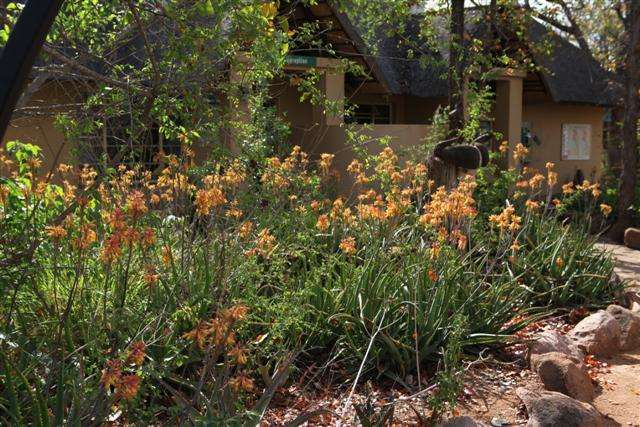 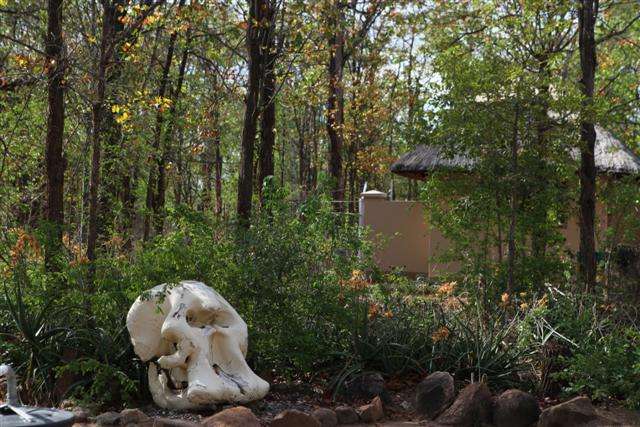 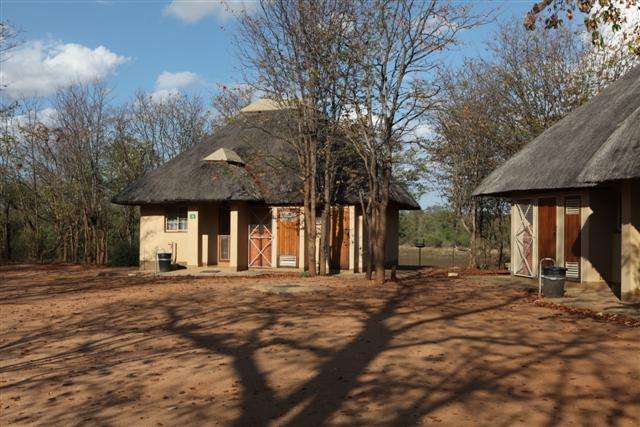 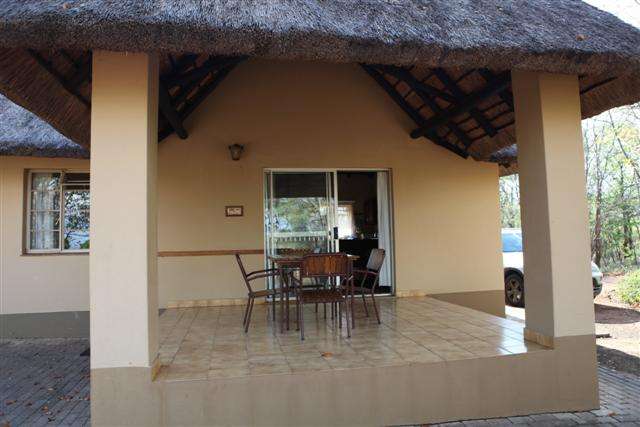  We were fortunately the last hut/chalet and up against the fence. 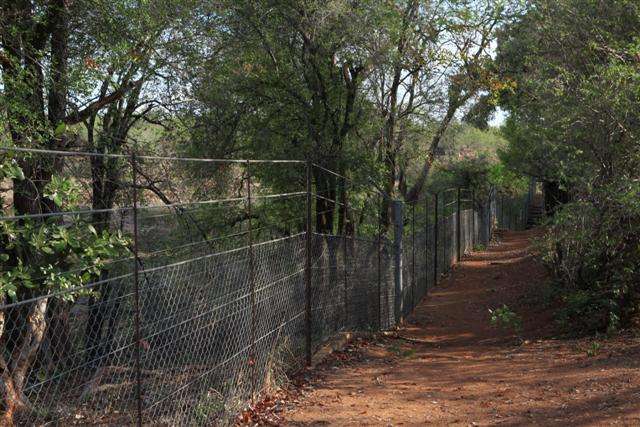 At this first camp there is no cellphone reception - no way to charge your cellphone - lighting supplied by generator - communal deep freezer - no hairdryer facility. Stove is gas. We had one bedroom with a double bed and a lounge which had to sleeper couches. The cost for 4 nights was R2,928-00 More to come....... |
|
|
|
Post by Deleted on Oct 31, 2012 14:59:57 GMT
Okay, you have already proved that you are going to outdo yourself again with the photos. I am throwing my camera away.  |
|
|
|
Post by bjd on Oct 31, 2012 15:35:51 GMT
That close-up of the eagle is superb.
|
|
|
|
Post by tod2 on Oct 31, 2012 17:36:34 GMT
Kerouac - Just hold it right there Mr.! Your photos are incredible.......just not of wild animals ;D
bjd - Thanks! That was a lucky shot but also I will confess my sins right now......I tricked him into thinking he was being challenged by another eagle. To do this one has to have the Sasol or Roberts bird list on your cellphone. I find the Fish Eagle then play its call over and over. The poor bird gets very concerned but stays stuck to its branch long enough to be properly photographed!
|
|
|
|
Post by mossie on Oct 31, 2012 19:26:10 GMT
Fascinating. How thrilling to get such close ups.
|
|
|
|
Post by Deleted on Oct 31, 2012 19:34:41 GMT
The eagle certainly looks like it is ready to attack if it can only figure out the threat.
|
|
|
|
Post by htmb on Oct 31, 2012 22:01:23 GMT
Fabulous photos and narrative, tod. I'm looking forward to more!
|
|
|
|
Post by fumobici on Nov 1, 2012 1:12:00 GMT
Oh goody! The last Kruger report will be difficult if not impossible to surpass but we're off to a good start.
|
|
|
|
Post by Kimby on Nov 1, 2012 3:38:42 GMT
Love the eagle shots, and how interesting the way you got his attention.
The Sirheni Bush Camp looks lovely.
Looking forward to the rest of your report and your stunning wildlife photos.
|
|
|
|
Post by nycgirl on Nov 1, 2012 5:12:31 GMT
Yay, more Kruger adventures!
We booked the Sable hide, too. I'm really looking forward to the view. You're right about it being the perfect spot for a big group of friends.
That fish eagle is so gorgeous! Great shot, and very clever of you to get him to pose so beautifully.
Those baby elephants are so cute. From what I understand, they breed year-round, so we'll have a goo chance of seeing little ones, is that right?
Can't wait to see more!
|
|
|
|
Post by bixaorellana on Nov 1, 2012 5:43:21 GMT
Oh, Tod! Endlessly interesting stuff from you, as usual, and naturally, great pictures.
Is this the first time you all did the far northern part of the park?
I think the huts/chalets look downright luxurious!
|
|
|
|
Post by nycboy on Nov 1, 2012 14:56:50 GMT
Beautiful clouds in those Sable Hide pics too, what a perfect sky for photography. Fascinating with the eagle call too, I'm going to have to rig something up for us when we're out there.
|
|
|
|
Post by tod2 on Nov 1, 2012 14:58:10 GMT
Thanks so much all of you for the compliments! Nycgirl - I've been reading your post on the hurricane and must thank you for an on-the-spot view of all that happened. Really so sorry for the families that suffered damage and upheaval during this time. I am wondering if you two will be the only ones in the Sable Hide that night?? That would be more romantic! You asked about seeing baby elephants - Yes , most definitely. There is a breeding herd down the south end of the park in the vicinity of Lower Sabie, but there are lots at the northern end. As a matter of fact all one comes across regularly are elephants especially the enormous bull elephants. Keep your distance to at least 30m, don't drive up behind one, and reverse slowly if one is trundling down the road towards you, or at least stay stationary. I'm a scaredy-cat and always back off! Eventually they go back into the bush to feed. To continue.... We spent our first night watching for hyenas along the fence while we enjoyed a braai. A little later we heard a few hippos grunting. The river bed was dry in front of the chalet but we could see where the water was further up stream. Sitting on our patio we breathed in the warm evening air and listened to lions roaring across on the other side of the river. This was terrific as we have never experienced any roaring lions on any of our trips to Kruger! Growling at a kill, yes - but roaring in earshot of our camp....never. Next morning we packed a picnic breakfast and lunch and headed for Punda Maria and the Pafuri area. There is a beautiful shady area set aside for picnics at Pafuri as well as the famous Crooks Corner where South Africa, Mozambique and Zimbabwe look at each other from across the Limpopo and Luvuvhu Rivers (pronounced La Vu Vu). On the way we encountered a herd of Buffalo and saw them cooling off in the river. 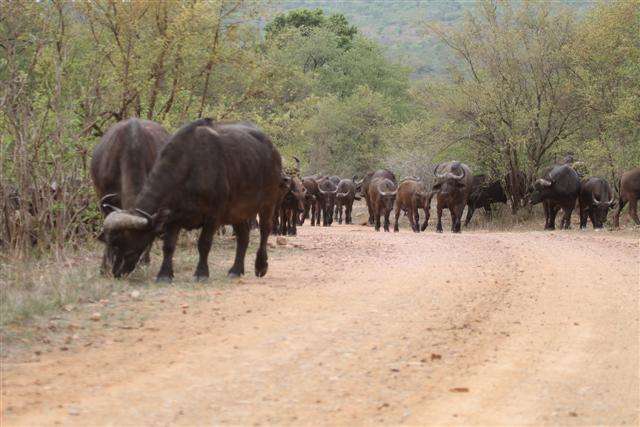 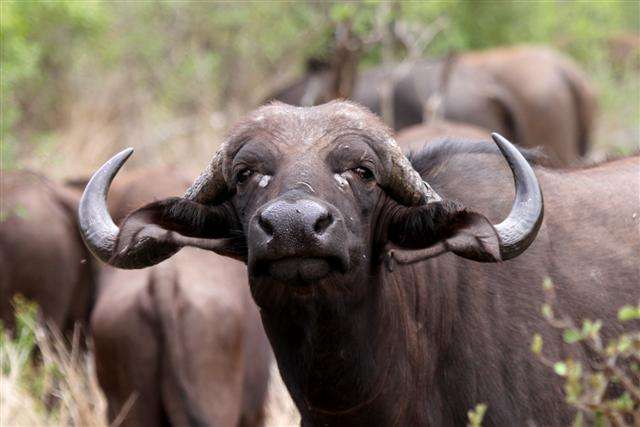  Going across a bridge a little while later we had fun watching the elephants dust bathing. 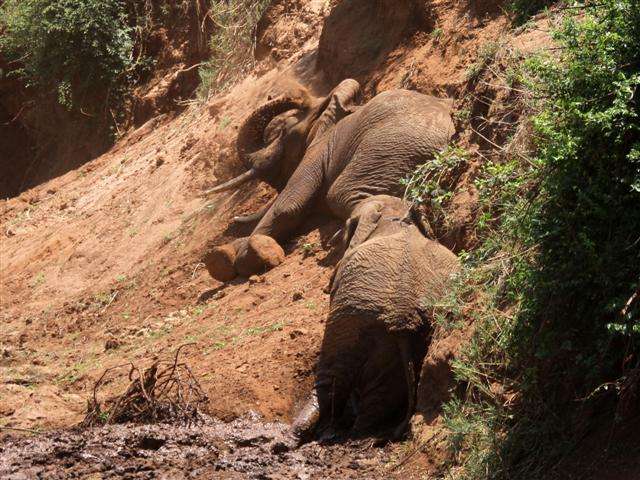 Will continue with our journey ...... |
|
|
|
Post by nycboy on Nov 1, 2012 17:28:45 GMT
Love that shot of the bend in the river.
My understanding was that we get the hides to ourselves when we reserved them, though it wasn't going to be very romantic with my parents there. Unfortunately since we planned the trip my father was diagnosed with bladder cancer and won't be able to come. Mom might still join us but it'll depend on what course they take and how he reacts to the treatments. They're going for a consultation about that tomorrow, but the good news we just got yesterday is that MRIs didn't turn up cancer in other likely spots, so it's just one battle for him to undertake.
|
|
|
|
Post by tod2 on Nov 1, 2012 17:53:26 GMT
Oh I am sorry to hear that news. I hope he makes a full recovery.
I have a lot of editing to do on the next lot of photos - trying my best to keep the momentum going...
|
|
|
|
Post by Deleted on Nov 1, 2012 18:14:42 GMT
The dust bathing is for parasites, right?
|
|
|
|
Post by Deleted on Nov 1, 2012 18:47:43 GMT
Another fabulous stunning report Tod.
Those eagle pics are amazing!!
Thanks for this!!
(The eagle call cell phone thing reminds me of a garden client I had years ago who was trying to lure Purple Martin swallows to her housing unit built for them. She got a tape of the Purple martin dawn song and would play it on her stereo to try and lure. It didn't work and drove the neighbors crazy she would crank it up so loud right at dawn!!!)
|
|
|
|
Post by nycboy on Nov 1, 2012 21:50:20 GMT
Just watched the dust bath videos, how amusing. He looks so comfortable laying there on his side.
|
|
|
|
Post by tod2 on Nov 2, 2012 7:06:46 GMT
Yes, quite correct Kerouac but you would think there isn't a tick or flea alive that could penetrate an elephant hide! Come to think of it, we have never seen an egret (cattle egret) or the red bill ox pecker's attach themselves to elephants  Maybe the dust and mud baths are also to keep off the blazing sun. There you go Nycboy - please ask one of the game rangers when you are in Kruger! Those bathing Ellie's were something we have never seen before - lying down like that I mean. |
|
|
|
Post by tod2 on Nov 2, 2012 8:06:51 GMT
Some more animal sightings on our drive to the top end of Kruger. This is a Nyala male. The markings and long hair make him stand out anywhere. 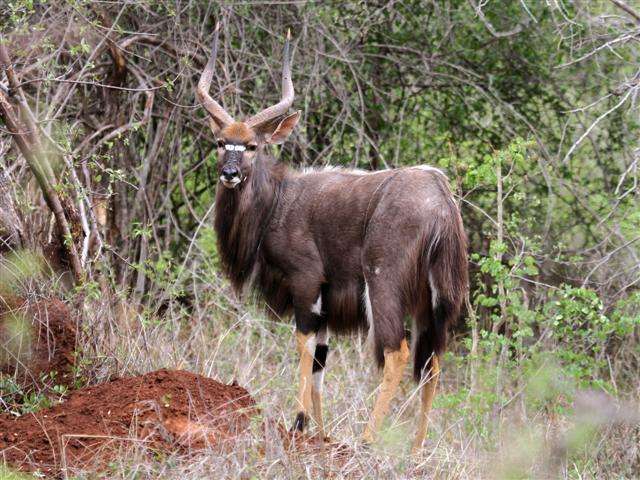 Those look like flies on his nose...  All of a sudden he went into a strange stance - showing off his unusual coat and tail. Another Nyala was approaching. Probably entering his turf. 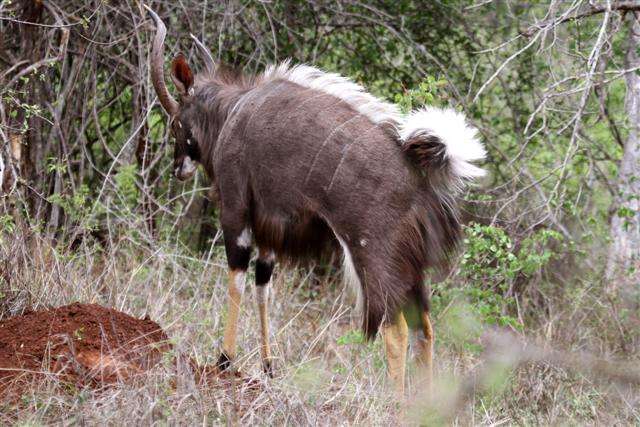  Looking around we noticed a group of female Nyala's so this must have been his harem. 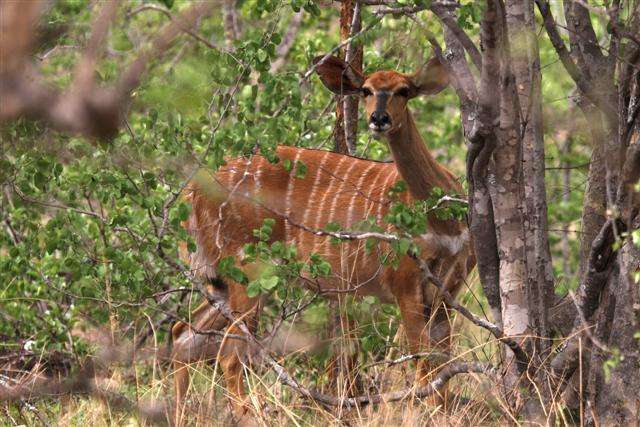  This almost 'cow-like' individual is called a Tsessebe. You don't often see them and I think they are only in this upper region of Kruger. 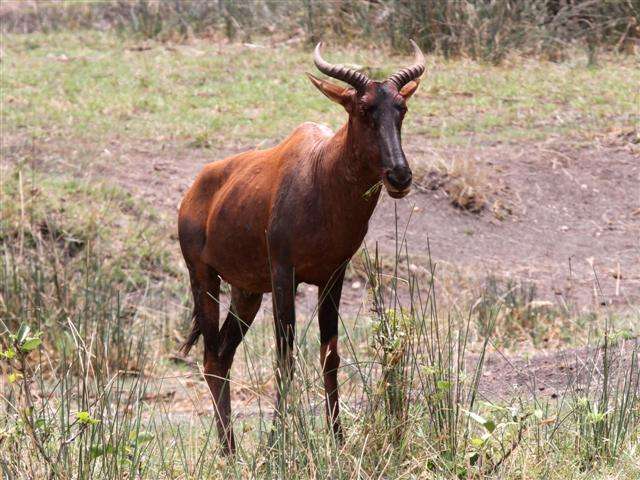 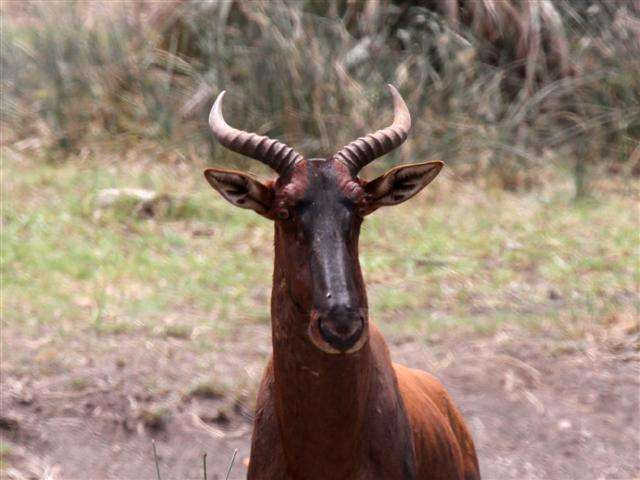 Many buck graze happily with zebras or wildebeest. 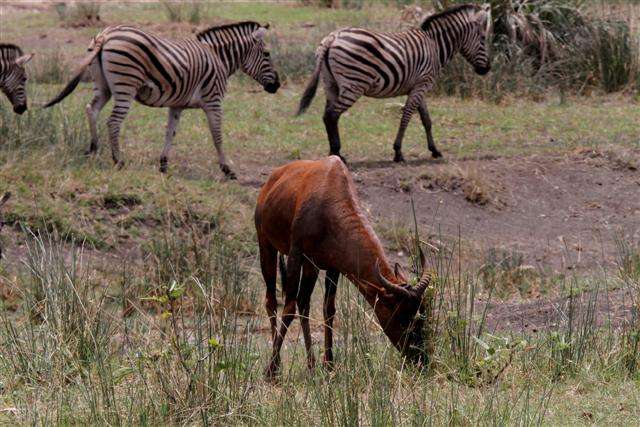 It is at this top end of Kruger that one comes across the most Baobab trees in the park. There is one marked on the guide books as the most southern baobab - but this is not true! I know of two young baobab trees growing in Malelane camp site. this camp is right on the lower border of Kruger. This one has been damaged by the elephants - Yes, there are the culprits! 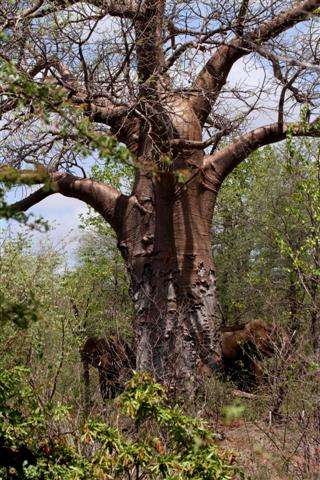 Actually I am on a mission this trip - to find boabab's that are in flower. This one hardly even had leaves. But as luck would have it, my second mission was accomplished by finding a Sausage Tree with a few blooms. These had fallen to the ground so I had to open my door and retreive them. Shhhhh   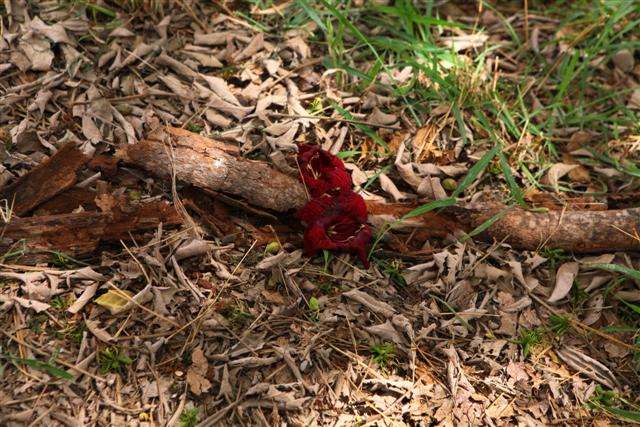 I borrowed them for a better close-up. 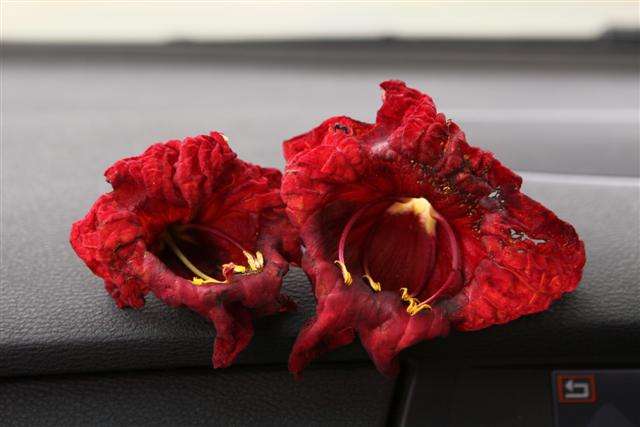 More later..... |
|
|
|
Post by Deleted on Nov 2, 2012 12:58:48 GMT
Some animals, like the kudus and the zebras always look perfectly well groomed, almost as though they had been brushed.  Some of the others like the buffalos don't seem to mind looking a bit scraggly and disheveled. I would never expect such a lush looking flower to grow on a tree like that. |
|
|
|
Post by mossie on Nov 2, 2012 15:56:56 GMT
Super.
|
|
|
|
Post by tod2 on Nov 2, 2012 17:41:42 GMT
Mossie and Kerouac - those "Sausage Tree" flowers are as big as the palm of your hand. As I wander through the two weeks we were there I will show you more flora from this tree and of course my 10 day wait until I finally found what I was looking for!
|
|
|
|
Post by bixaorellana on Nov 3, 2012 5:57:21 GMT
I won't tell on you, Tod! This is such an enjoyable report, & the botanical stuff makes it even more interesting.
The female kudus are so beautiful and elegant. Great pictures of everything!
NYCBoy, sorry to hear of your dad's illness, and sending wishes for an excellent & swift recovery.
|
|
|
|
Post by tod2 on Nov 3, 2012 15:21:50 GMT
First off I must apologize for calling a Nyala, a Kudu! Well, let's continue - Traveling along the main road north and elsewhere, there are many round reservoir's for the animals. I guess it must be piped to a lower basin for buck etc., but elephants come right up to the cylinder and as you can see, their tusks break away the cement casing leaving a chipped edge. 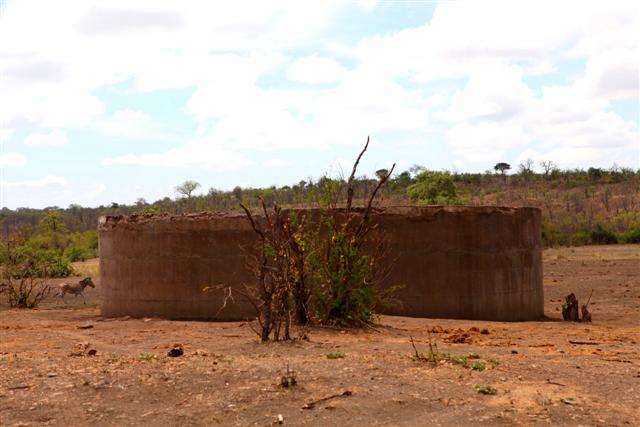 A shallow trickle in a river gives these elephants a cooling mud bath. I spot a cattle egret lurking. I love the way the elephant stirs up the mud with it's foot! Here we are at Punda Maria - 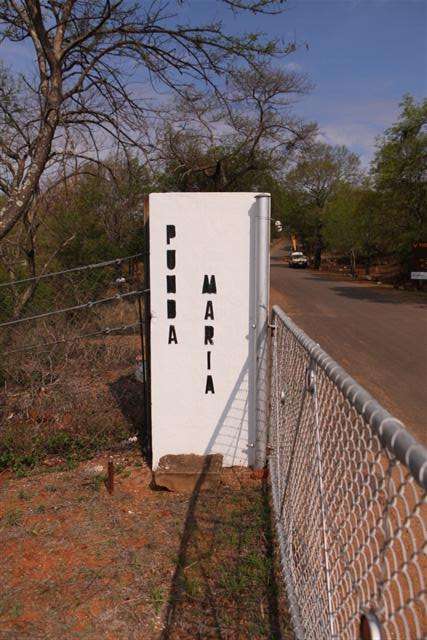 What's in a name like Punda Maria? sounds positively Mexican ;D Let me tell you: The name Punda Maria is a bastardization of the Swahili word for zebra - which is 'punda miliya'. The name of the camp was coined in 1919 by the first ranger in charge of the area, J.J. "Ou Kat" (old cat)Coetser, who named it after his wife Maria. She apparently hated the rigors of living in such an isolated part of the country and had a predilection for striped dresses. Coetser himself was fired as a ranger for shooting animals and was eventually killed by a bull elephant near the Limpopo river. The Parks Board renamed the camp and the gate as Punda Milia under the impression that it had been a spelling mistake and that the zebra were the first animals seen in the area. After representations from Coetser's family in 1979, the original name was restored. The camp is old and the accommodation shows the old fashioned buildings. Formerly a Game Rangers quarters it was turned into a tourist camp in 1933 retaining the same buildings. This is the only main camp we have not stayed at yet. The drive into the camp: 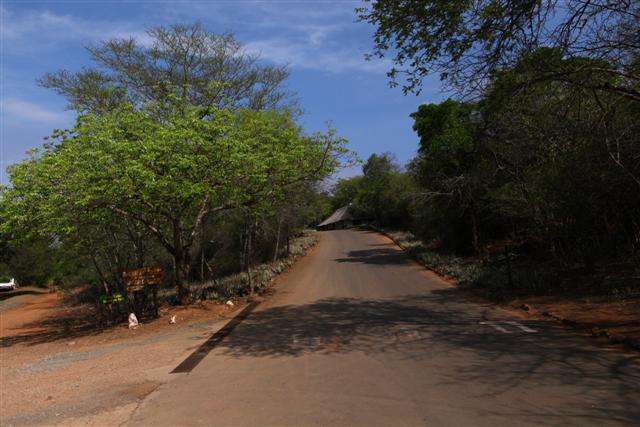 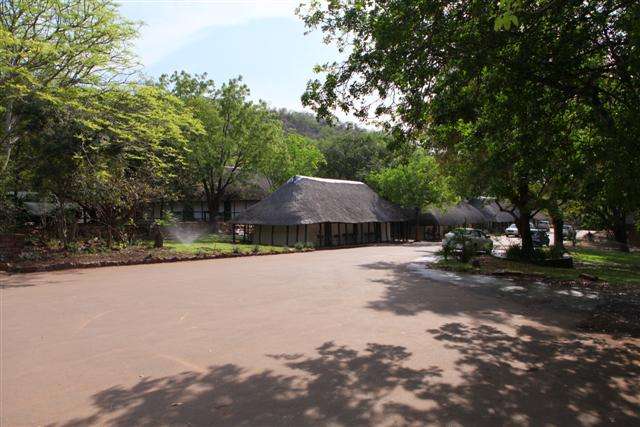 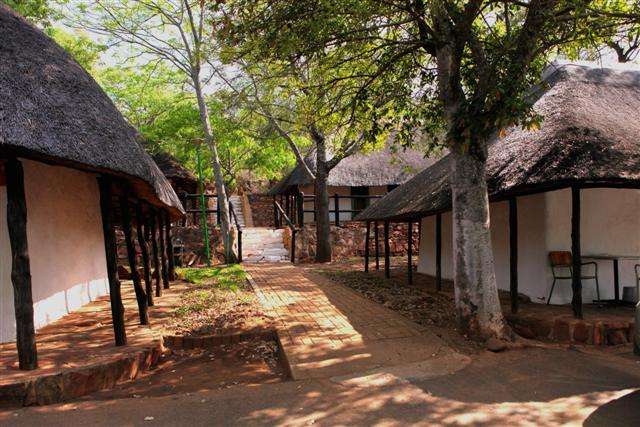 The second row of accommodation behind the street view bungalows, to my mind is preferable and quieter. My choice is number 20/21. 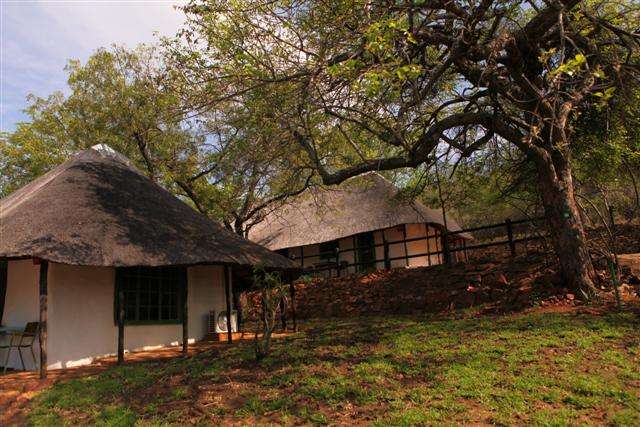 Traveling north=east from Punda Maria on the dirt roads, the S60 - we come across this ancient baobab just starting to show it's new spring leaves. This tree has a rusty old tag nailed into the bark but is unreadable. The tree is associated with a great deal of folklore on Ghumbandebvu Hill, named after a chief who's daughter Khama was believed to possess rain-making skills. 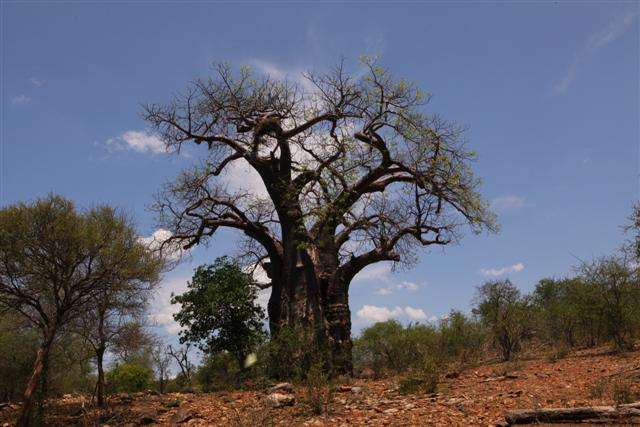 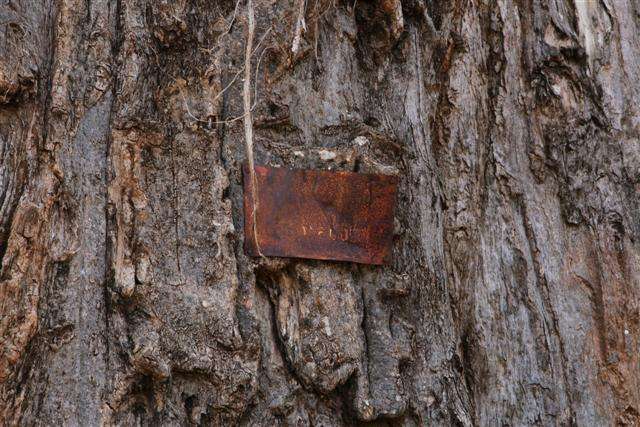 The road joins back onto the H1-8 and divides at the road leading to the Thulamela Archaeological site. We briefly go and see the site but cannot access it without a guide as the road is cordoned off by chains. Instead we go and have lunch at the Pafuri Picnic site on the S63 dirt road. We have been here several times. 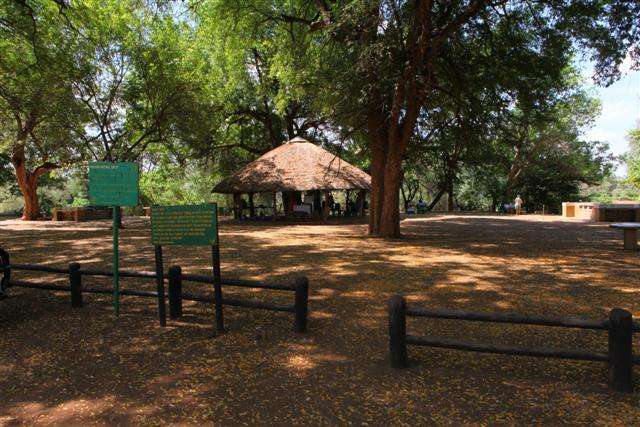 The monkeys are extremely active and will come right down onto your table and grab some item of food. This inquisitive monkey had another curiosity - a beaded chameleon mascot on the front of a 4X4. 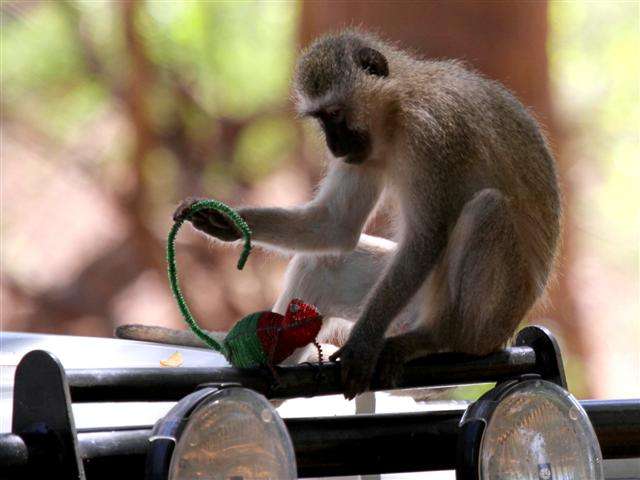 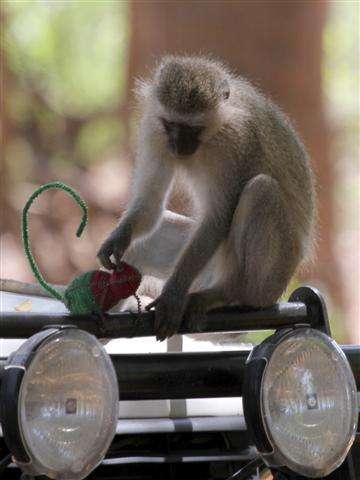 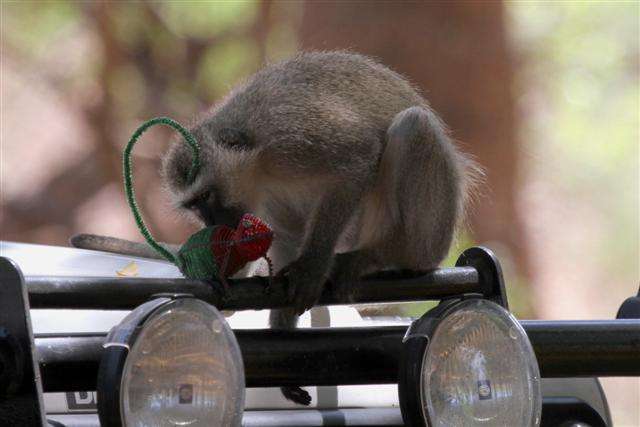 A must after ones lunch is a visit to Crook's Corner. It got it's name from the outlaws who lived here during the late 19th and early 20th centuries. Because of these three sovereign territories that met at the confluence of the Limpopo and Luvuvhu rivers - Portuguese East Africa, Southern Rhodesia and South Africa - it was relatively easy to avoid the law by hopping over into a neighboring territory. It became a haven for ivory poachers, gun-runners and illegal tribal labor recruiters. A trading store in the area was the important supply and meeting point for the rogues.  Looking towards Zimbabwe-  A quick visit to see the extreme gate of the Kruger Park at Pafuri pays dividends when in 39C I meet an old man outside the office. We exchange some views on the hot weather and I ask him if he knows why there are no flowers on the baobabs. He tells me there is a baobab in full flower at Balule campsite. This is a satellite camping ground to Olifants main camp. I am thrilled but worried that the show will be over by the time I get there in about 5 days time. 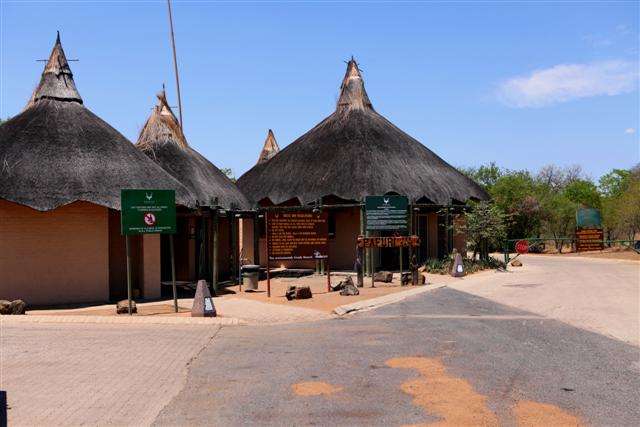 The long drive back results in only more buffalo and elephant - and a buck here and there. Also in evidence powering overhead were the intrusive electricity pylons that carry electricity to South Africa from Mozambique's Cahora Bassa Dam. 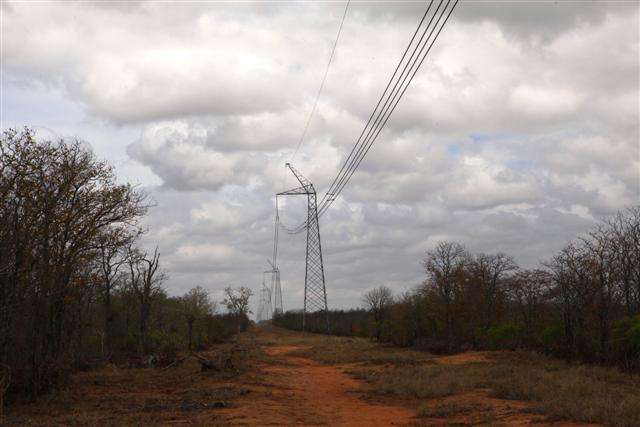 By the time we reach Sirheni the long shadows have fallen on the dry river bed and a lonesome elephant comes to graze in the reeds nearer the water further down.  The braai is soon on the go and a delicious rack of lamb sizzles away accompanied by pita bread(made by a real Greek)  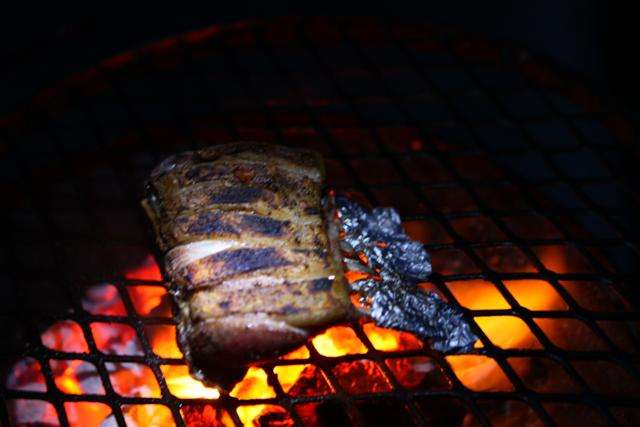 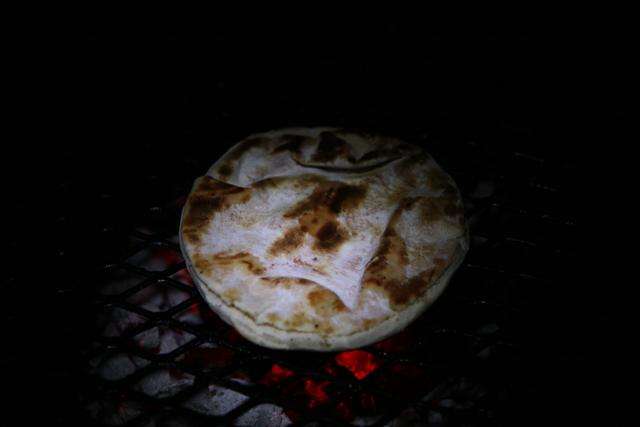 Adding some animals with the next lot of photos...... |
|
|
|
Post by tod2 on Nov 4, 2012 9:29:55 GMT
The lions roared again for a short while in the early evening - I find this quite thrilling! This morning we decide to keep looking for animals northwards. Setting off at 6.30am we find the gates still shut. The relaxed atmosphere at the smaller bush camps allows one to open the gate at daylight but close it after you. 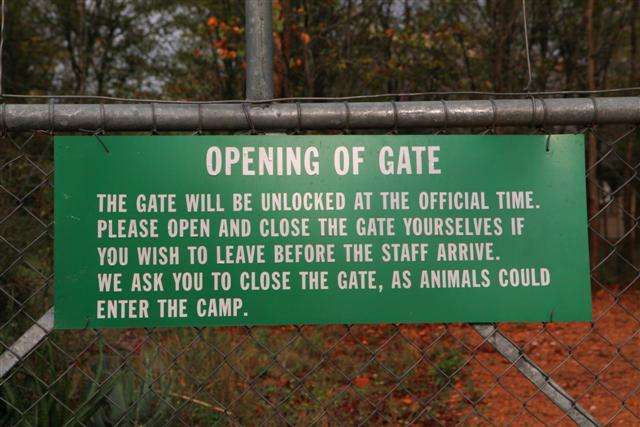 We have packed breakfast and lunch and take our little dirt road - S56 - to the Babalala Picnic spot. It is still deserted when we get there for breakfast. It has a lovely thatched area with a large Natal Mahogany tree growing out of the centre of the roof. It is an Evergreen tree which bears fruit in clusters which is good for the birds. 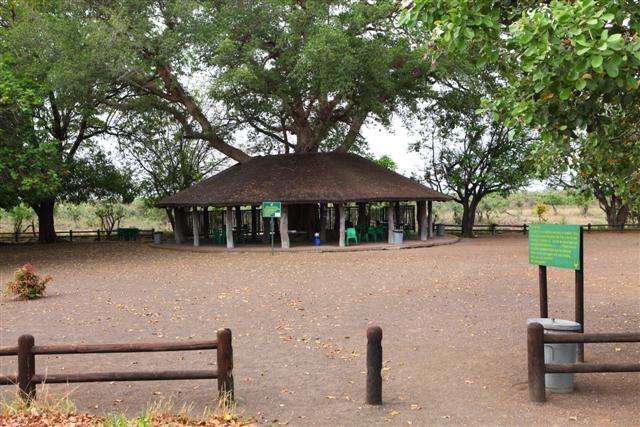 Just when there appears to be slim pickings when it comes to animals we are surprised by an enormous herd of buffalo coming through the bush surrounding a large waterhole. 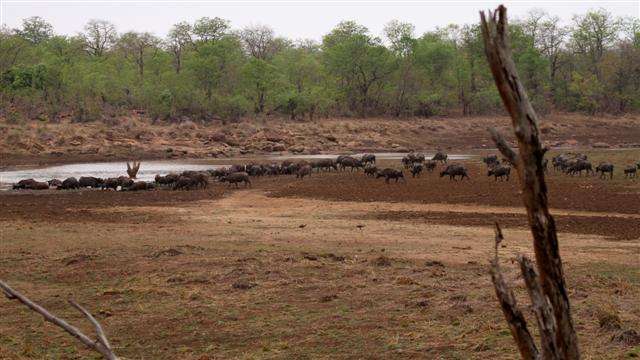 Giving up on animals we start photographing our surroundings. 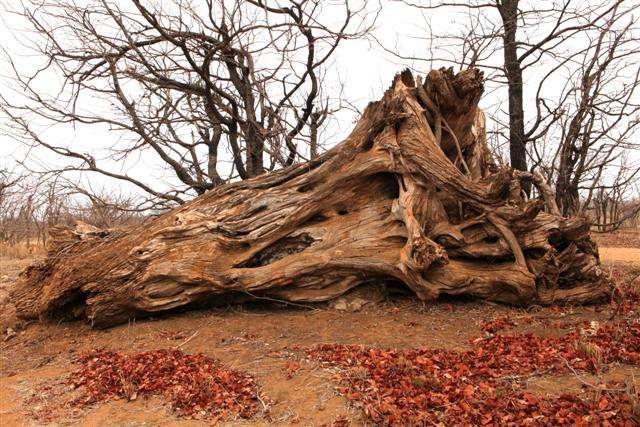 Lala Palms - seen a lot but not in or near water. 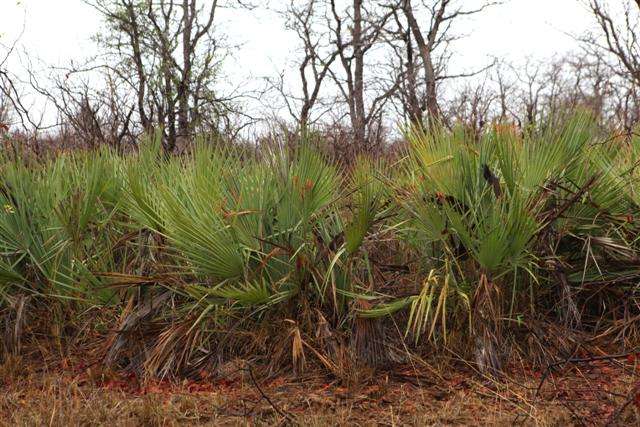 Its early afternoon when we decide to head back to Camp de brousse de Sirheni which overlooks Barrage du Sirheni, and pack for our move to another busveld camp called Bateleur. As a farewell present from this Northern end of the park we come across a young lioness! She only allows us a few minutes to get a few shots before she's off. 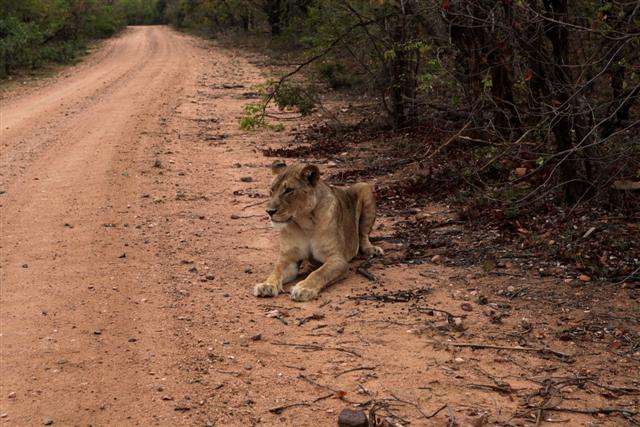 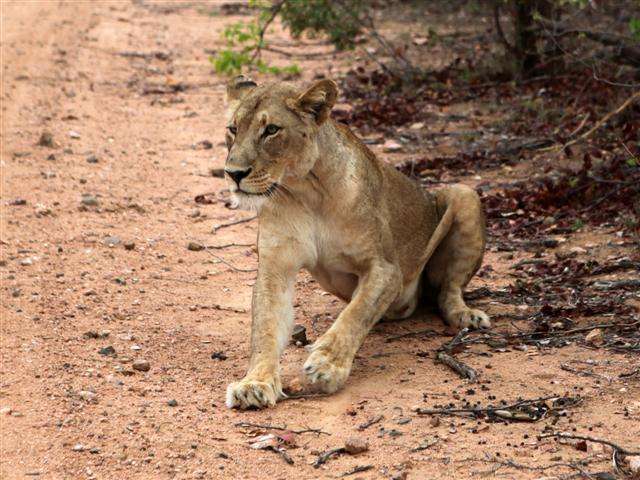 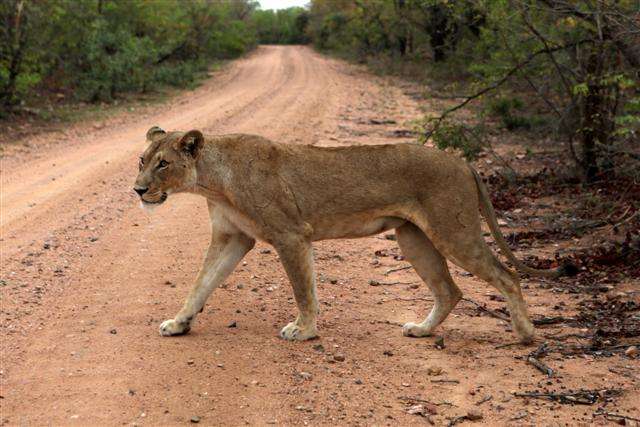 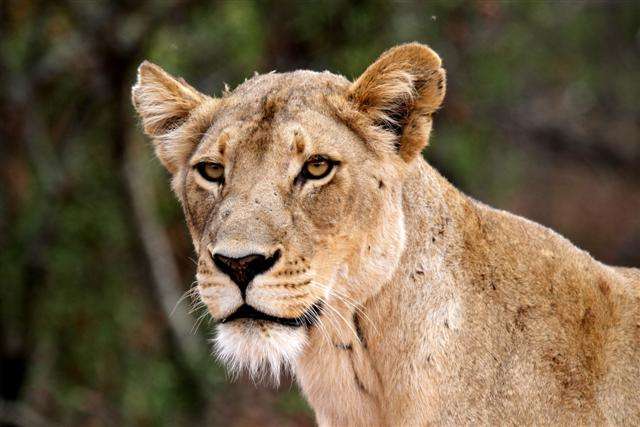 Better viewing comes our way as we move southwards....... |
|
|
|
Post by onlymark on Nov 4, 2012 11:04:01 GMT
Love the photos. Makes me itch to get back to Africa. Yes, quite correct Kerouac but you would think there isn't a tick or flea alive that could penetrate an elephant hide! Come to think of it, we have never seen an egret (cattle egret) or the red bill ox pecker's attach themselves to elephants  Maybe the dust and mud baths are also to keep off the blazing sun. As far as I know the skin is more sensitive than you'd think and the dust/mud is used more for sun protection than ticks and mites. |
|
|
|
Post by tod2 on Nov 4, 2012 13:57:48 GMT
Mark- we will have to do some research won't we?  Moving camp is a lot of work if you bring enough supplies for 2 weeks or more! Keeping the meat frozen is the most important as other veg and groceries are readily available ( but not always of the highest quality when it comes to fresh produce). Meat is available but from the look of some of it - I would become a vegetarian : and that's saying a lot! Huts must be evacuated by 10am but can only be re-occupied after 2pm. This left us with all our supplies shut tight until reaching Bateleur later that day. Bateleur camp is south but very near Sirheni actually. One passes Shingwedzi camp and turn off from the H1-6 onto the R52 dirt road. In the meantime we had sightseeing to do so set off quite early. Or first amusement was watching a group of Vervet monkeys while eating our breakfast. The mothers are incredibly good with their babies, unlike some baboon mothers we have watched. 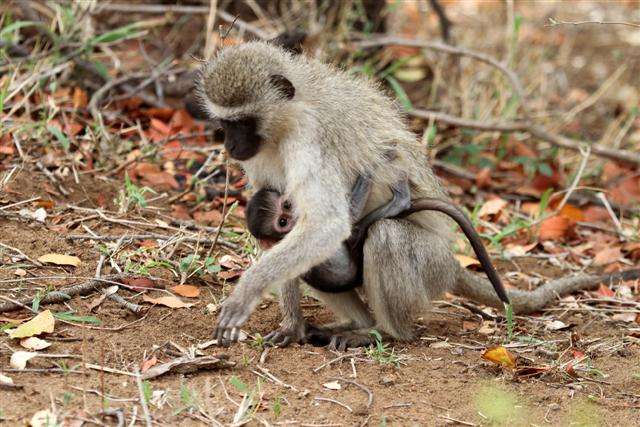 The baby seems continually attached to one of the teats. 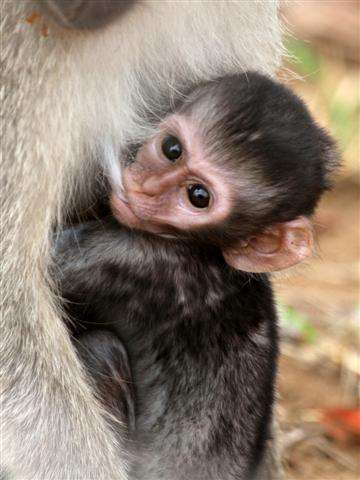 The grunting in the video was from these happy fellows. 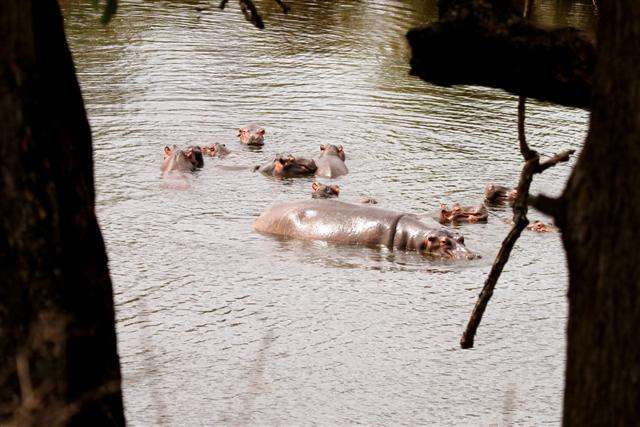 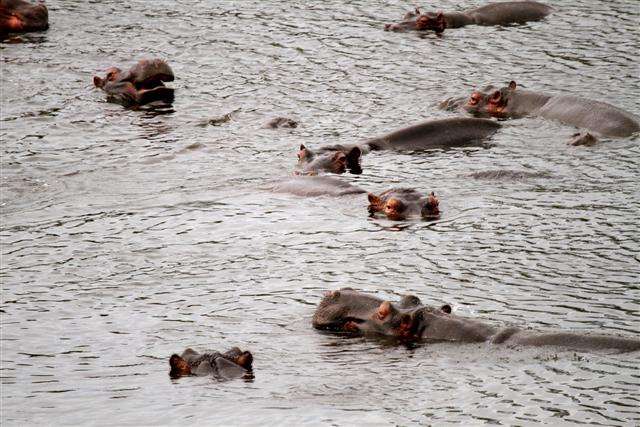 Other occupants of this watery heaven were catching some rays on a nice warm rock. 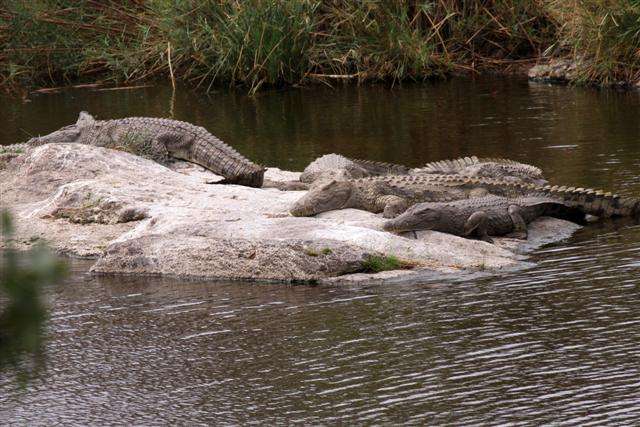 Very close to these jaws a mother Grey Heron on a nest. 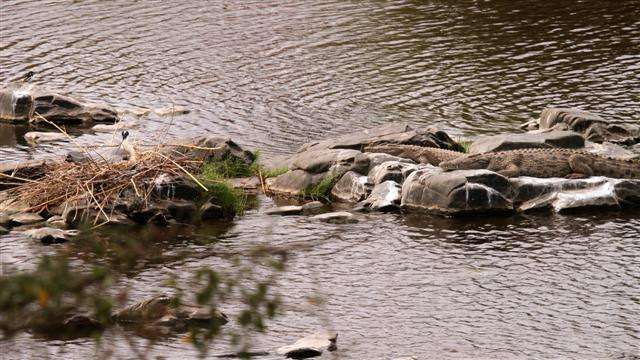 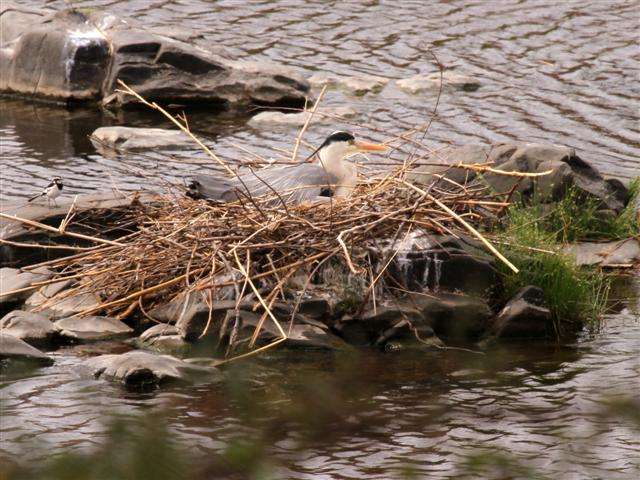 We now head past Shingwedzi, following the Shingwedzi River to the Kanniedood Hide to see whats there. Overhead in a tree alongside the dirt road we spot this Steppe Buzzard. 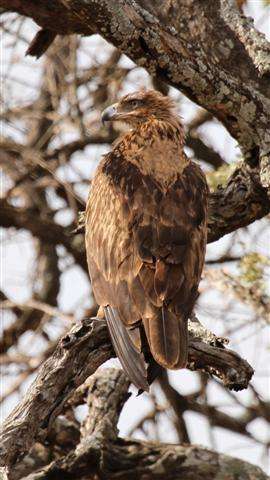 Ahead a group of vehicles has pulled over and we ask what all the excitement is about. Pointing to the far bank someone has spotted a male lion guarding his kill (directly behind him). 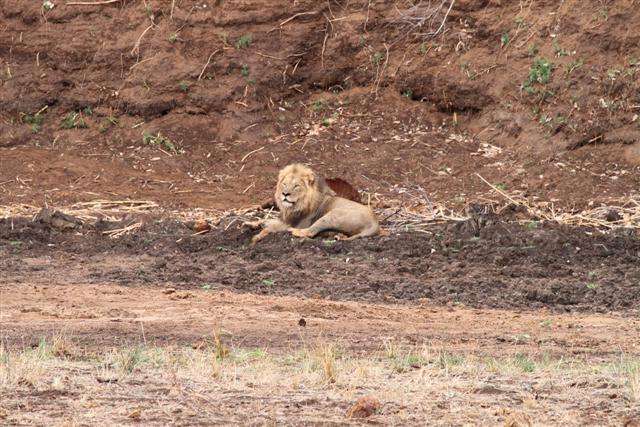  This is the hide. On stilts with vehicle parking underneath. 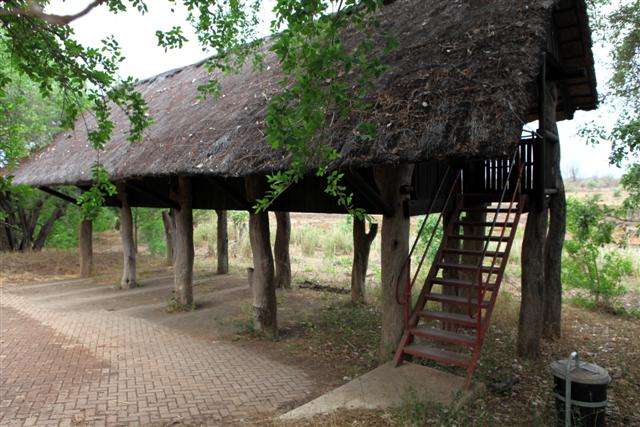 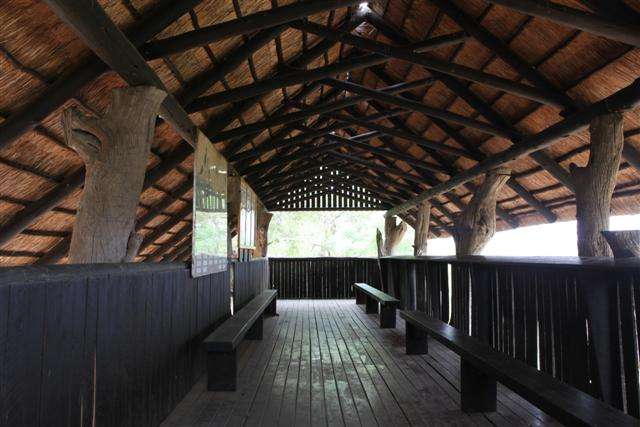 The Tree Wistaria's were in full bloom all over the park.  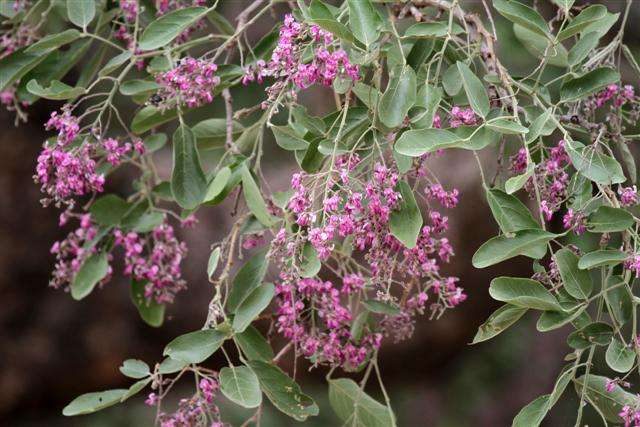 Next: Our new camp |
|
|
|
Post by mich64 on Nov 4, 2012 17:28:45 GMT
Tod I can understand why you return to holiday in the Park. Each report showcases how many different opportunities present themselves when leisurely scoping out your surroundings.
I love the photos of the hippopotamuses so much that I wish I could print, enlarge and frame them to put in one of my bedrooms where the kids usually stay the night.
How long does it take organizing for this type of holiday Tod? Your comments on keeping your meat refrigerated made me think that your menu planning requires much thought and planning.
|
|
|
|
Post by nycboy on Nov 4, 2012 18:28:46 GMT
I was wondering how much a frenched rack of lamb costs there?! We pay around $30 USD here in Manhattan. Did you visit a supermarket outside the park or bring the meat from home?
|
|




























































 Maybe the dust and mud baths are also to keep off the blazing sun.
Maybe the dust and mud baths are also to keep off the blazing sun.













 Some of the others like the buffalos don't seem to mind looking a bit scraggly and disheveled.
Some of the others like the buffalos don't seem to mind looking a bit scraggly and disheveled.









































